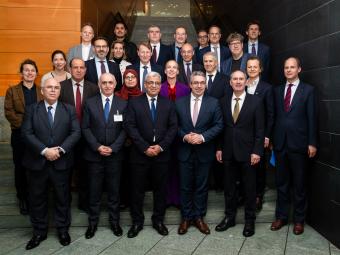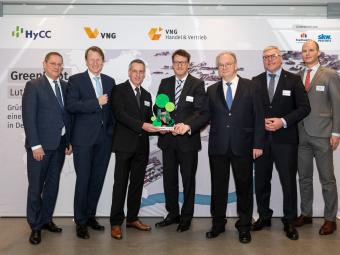Major milestone in the ‘Bad Lauchstädt Energy Park’ hydrogen project:
The development of the ‘Bad Lauchstädt Energy Park’ has taken another important step forward: Today, the project partners received official notification of funding as a ‘regulatory sandbox for the energy transition’ of around EUR 34 million in the presence of Saxony-Anhalt premier Dr. Reiner Haseloff, and presented by Andreas Feicht, State Secretary at the German Federal Ministry for Economic Affairs and Energy (BMWi).
“Hydrogen is not just a key element for the energy transition. It can also be a valuable building block for the development of a sustainable chemical industry and thus create added value and qualified jobs in the region of central Germany undergoing structural change. By funding regulatory sandboxes for the energy transition, the BMWi is supporting companies to bring their business models in line with the conversion of our energy system,” said Andreas Feicht to those attending the event.
Under the ‘Bad Lauchstädt Energy Park’ project, the project partners want to investigate the production, storage, transport and economic use of green hydrogen under real conditions on an industrial scale. After the BMWi had already declared the project eligible for funding as a regulatory sandbox under the two-stage application process in 2019, the responsible parties in the consortium have now pressed ahead with their plans in detailed form. “We are very happy to receive the long-awaited funding notification and to finally be able to get on with the real work. With this flagship project our shared ambition is to demonstrate that the industrial use of green hydrogen is absolutely feasible and cost effective,” said Cornelia Müller-Pagel, project manager in the consortium and head of the ‘Green Gases’ division at VNG AG. “Our project aims to continue research into green hydrogen as a ground-breaking future technology and to help bring this technology to market maturity. At the same time, our goal is to generate important momentum for this region and to turn central Germany into a technologically strong and future-oriented hydrogen region,” added Müller-Pagel.
“In the 1990s, we successfully developed the chemical park model in Saxony-Anhalt. I am firmly convinced that we will also be trailblazers with the Bad Lauchstädt Energy Park and that the model will become a success story. Today, we have fired the starting gun for a secure and climate-friendly energy supply for Germany,” said Saxony-Anhalt premier Dr. Reiner Haseloff.
With the formal notice of funding, project work will start immediately. Behind the ‘Bad Lauchstädt Energy Park’ is a consortium of companies consisting of Terrawatt Planungsgesellschaft mbH, Uniper, VNG Gasspeicher GmbH (VGS), ONTRAS Gastransport GmbH (ONTRAS), DBI - Gastechnologisches Institut gGmbH Freiberg (DBI) and VNG AG.
The aim of the collaborative project is to model the entire value chain for green hydrogen in southern Saxony-Anhalt. Renewable electricity from a new wind farm will be converted into climate-friendly hydrogen by means of a large-scale electrolysis facility with an output of around 30 megawatts (MW) and supplied to the chemical industry plants in neighbouring Leuna via a 20-kilometre gas pipeline operated by ONTRAS that is being repurposed. In addition, vital preliminary work is to be carried out to be able to temporarily store this green hydrogen in a specially equipped, almost 180-metre-high salt cavern from 2026. The total investment volume of the project is around EUR 140 million.
Plans are in place to develop and set up the energy park in two phases, which will be implemented independently of each other: Starting this autumn, the funding approved for the ‘regulatory sandbox for the energy transition’ will initially be used to further develop and test hydrogen generation and transport, as well as central components of hydrogen storage. These include, for example, efficient gas cleaning and safety technology. In a prospective second phase, which is not part of the current research project, the aim is to complete the cavern for hydrogen storage with the aim of integrating this underground storage facility into the value chain from 2026 onwards. Overall, the Bad Lauchstädt Energy Park is characterised by a high level of innovation and close interaction between the various stages of the value chain. It will also contribute to the decarbonisation of the chemical industry, which is dominant in this region. In the future, the energy park can also be integrated into the emerging European hydrogen infrastructure by means of further eastern German hydrogen projects.
With its National Hydrogen Strategy, the German government has decided to anchor hydrogen as an energy source in the energy system of tomorrow. Green hydrogen in particular has been given a key role in these plans, because it is produced from renewable electricity using electrolysis and is therefore particularly environment friendly. As part of its 7th Energy Research Programme, the BMWi previously launched the ideas competition ‘Regulatory sandboxes for the energy transition’ for the period from 2019 to 2022, with funding of up to EUR 100 million per year. The regulatory sandboxes for the energy transition are designed to promote the practical application of innovations.
About the ‘Bad Lauchstädt Energy Park’ project partners:
Terrawatt Planungsgesellschaft mbH has been developing and implementing turnkey projects in wind power and photovoltaics for over 25 years. With many years of experience as a planner, investor, operator and manager, the company is in a position to comprehensively manage all aspects of project implementation from the search for a suitable location through the turnkey handover of the systems and to the design the individual project phases with its own skilled specialists. In addition, the company is nationally and internationally active as a service provider and technical consultant, and can draw on a wealth of experience from over 300 projects with more than 1,500 wind power plants. More at: www.terrawatt.de.
Uniper is an international energy company with around 12,000 employees in more than 40 countries. The company aims to become carbon neutral in European power generation by 2035. With around 35 gigawatts of installed capacity, Uniper is one of the largest electricity producers in the world. Uniper’s core activities include power generation in Europe and Russia, and global energy trading, as well as a broadly based gas portfolio that makes Uniper one of the leading gas companies in Europe. In 2020, Uniper sold more than 220 trillion cubic metres of gas.
Uniper is also a reliable partner for municipalities, municipal utilities and industrial companies in the planning and implementation of innovative, CO2-reducing solutions as they decarbonise their activities. As a pioneer in the field of hydrogen, Uniper is active worldwide along the entire value chain and realises projects aimed at turning hydrogen into a central pillar of the energy supply architecture. The company is based in Düsseldorf and is currently the third largest publicly listed German energy supply company. Together with its main shareholder Fortum, Uniper is also the third largest producer of zero carbon energy in Europe. More at: www.uniper.energy/de.
VNG Gasspeicher GmbH (VGS) is currently the third largest gas storage operator in Germany with around 2.2 billion cubic metres of active storage capacity. As a wholly owned subsidiary of VNG AG based in Leipzig, VGS has almost 50 years of experience in the construction and operation of underground gas storage facilities and the related technological processes. The core business of VGS is the operation of storage facilities and the marketing of storage capacity. In addition, VGS acts as the technical operator for third-party storage facilities and provides engineering services for its customers in the areas of plant construction and measurement technology. More at: www.vng-gasspeicher.de.
ONTRAS Gastransport GmbH is a cross-regional transmission system operator in the European gas transport system, headquartered in Leipzig. ONTRAS operates the second longest transmission network in Germany with over 7,500 kilometres of pipeline and around 450 network connection points for customer gas transport. The company brings together the interests of transport customers, traders, regional network operators and renewable gas producers as a reliable partner. 22 biogas facilities and two power-to-gas plants feed green gases (biomethane, synthetic methane or hydrogen) into the ONTRAS network. More at: www.ontras.com.
DBI – Gastechnologisches Institut gGmbH Freiberg is a research institute of the DVGW e.V. (German Association of Gas and Water Industries). It researches the entire supply chain of gaseous energy sources in numerous projects. It has been working on projects for the integration of green hydrogen since 2005. The Institute’s experience ranges from underground gas storage and transport through to hydrogen utilisation technologies in industry and households. More at: www.dbi-gruppe.de.
VNG is a group of over 20 companies active in the European energy industry with a broad, future-oriented portfolio of products and services in gas and infrastructure, and more than 60 years of experience in the energy market. The Group has its headquarters in Leipzig, Germany, employs approximately 1,300 people and generated billed revenue of approximately EUR 9.8 billion in the 2020 financial year. VNG concentrates on four links in the gas value chain: Trading & Sales, Transport, Storage and Biogas. Building on this core expertise in the gas business, the Group’s ‘VNG 2030+’ strategy places a growing focus on new business fields, including ‘green gases’ and digital infrastructure. More at: www.vng.de.
Contact
BAD LAUCHSTÄDT ENERGY PARK c/o VNG AG
Braunstraße 7, 04347 Leipzig • Postfach 24 12 63, 04332 Leipzig
Tel. 0341 443 2961 • Fax 0341 443-2007
www.energiepark-bad-lauchstaedt.de • info@energiepark-bad-lauchstaedt.de
Contact person: Cornelia Müller-Pagel, project manager in the consortium
Press images
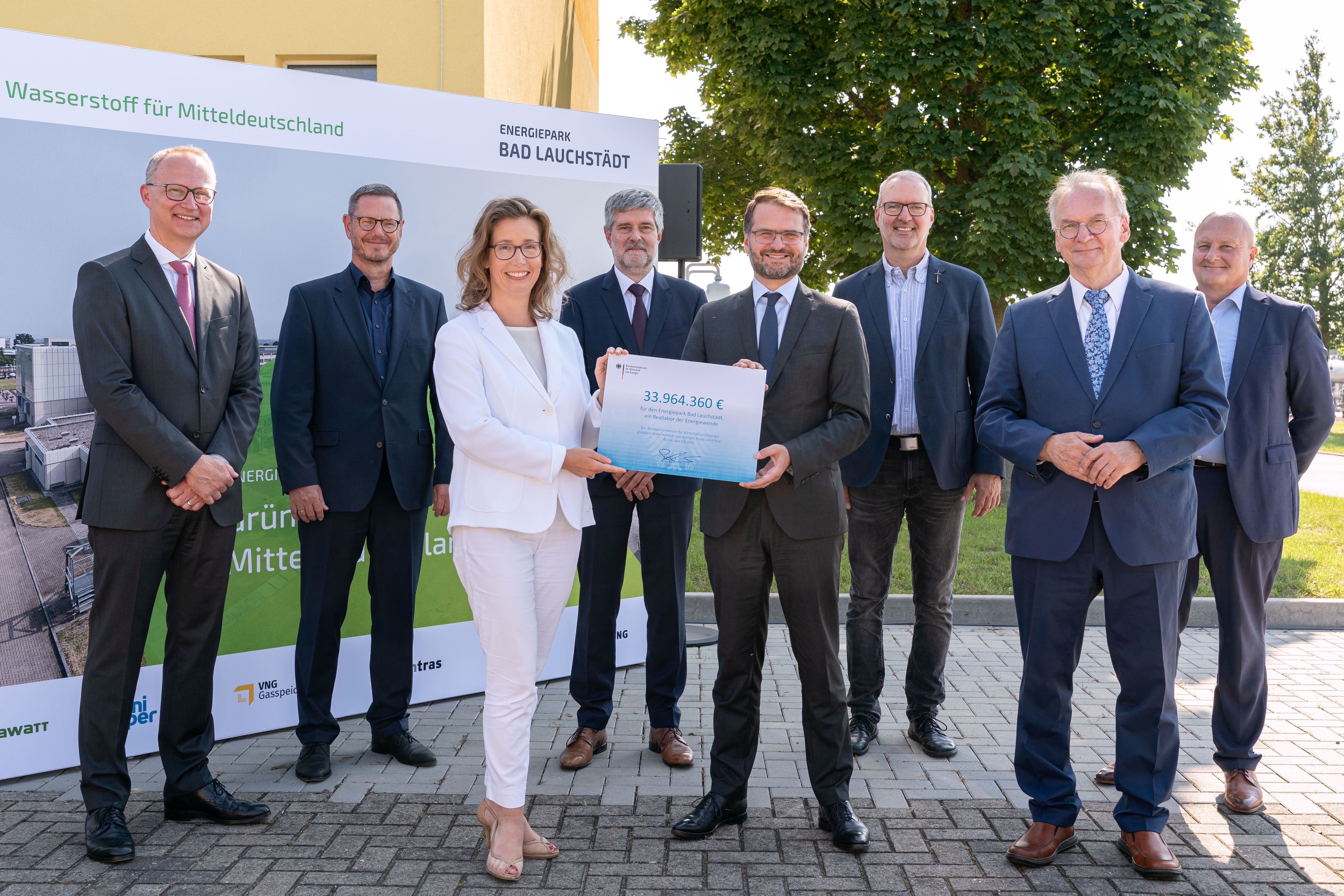
Presentation of the funding notification for the ‘Bad Lauchstädt Energy Park’
From the left: Dr. Axel Wietfeld, uniper | Uwe Ringel, ONTRAS Gastransport | Cornelia Müller-Pagel, VNG AG | Prof. Dr. Hartmut Krause, DBI | Andreas Feicht, BMWi | Falk Zeuner, terrawatt | Dr. Reiner Haseloff, Saxony-Anhalt premier | Bernd Protze, VNG Gasspeicher GmbH
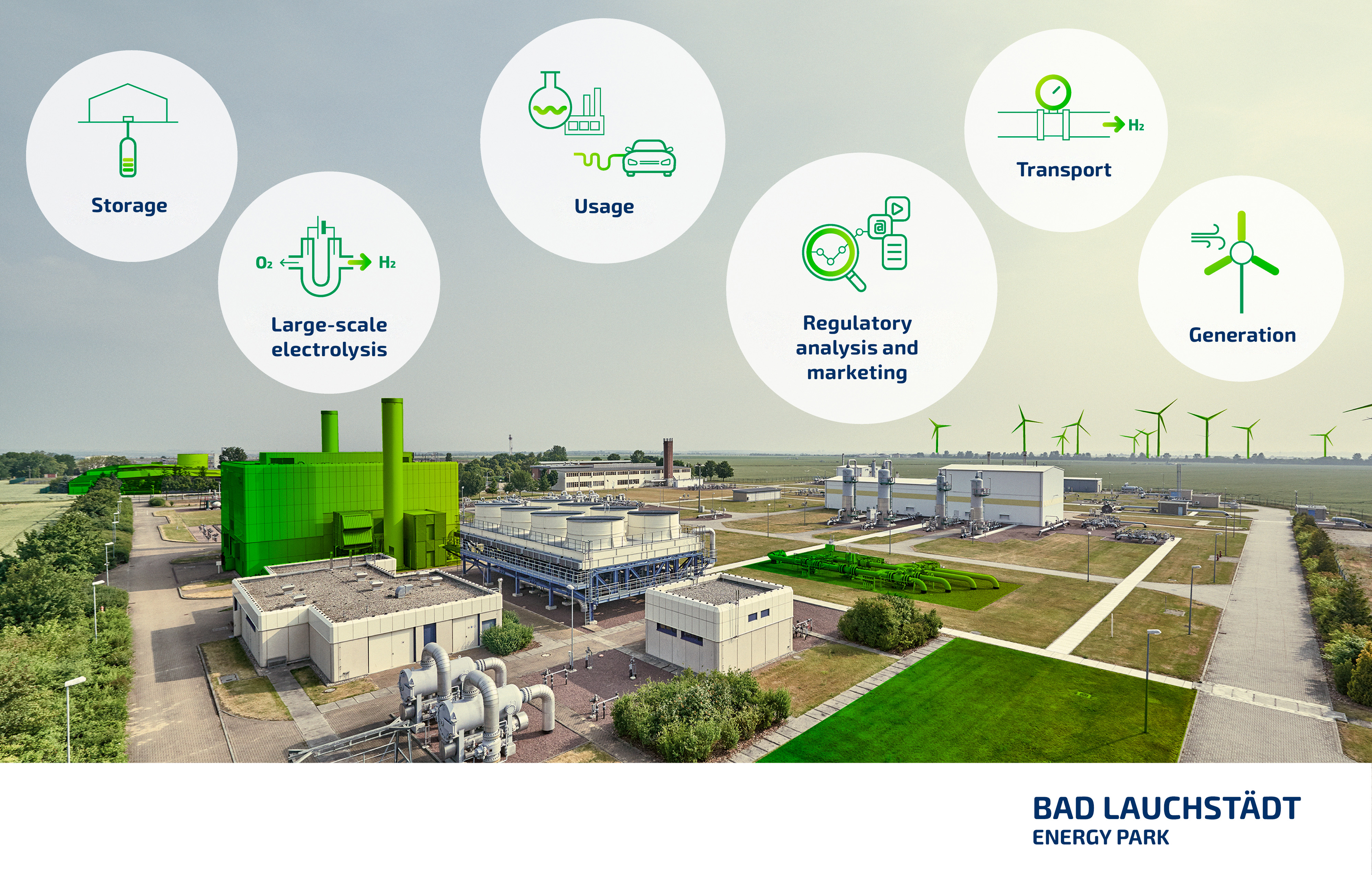
Setup of the ‘Bad Lauchstädt Energy Park’
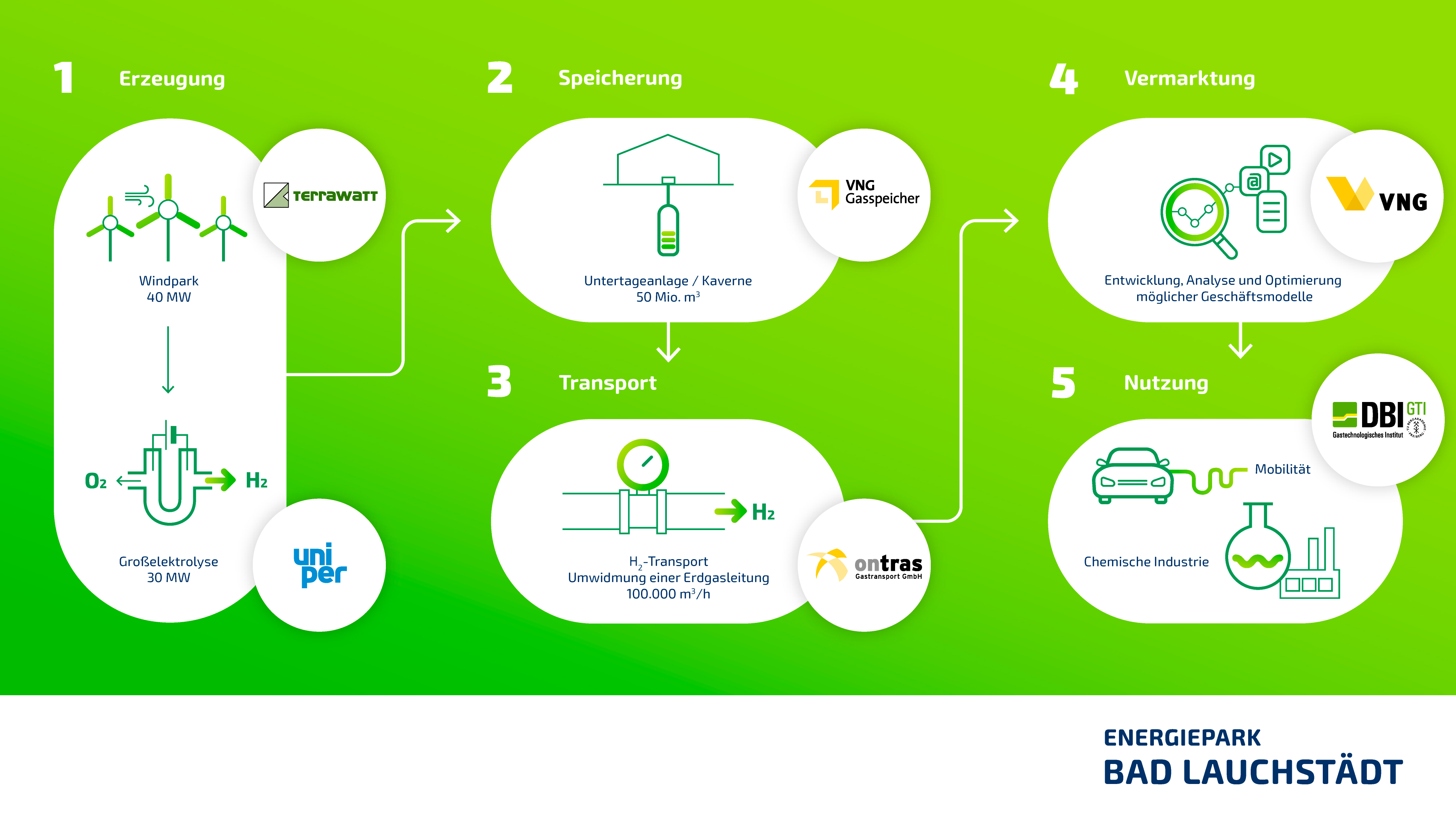
Setup of the ‘Bad Lauchstädt Energy Park’ (schematic presentation)
